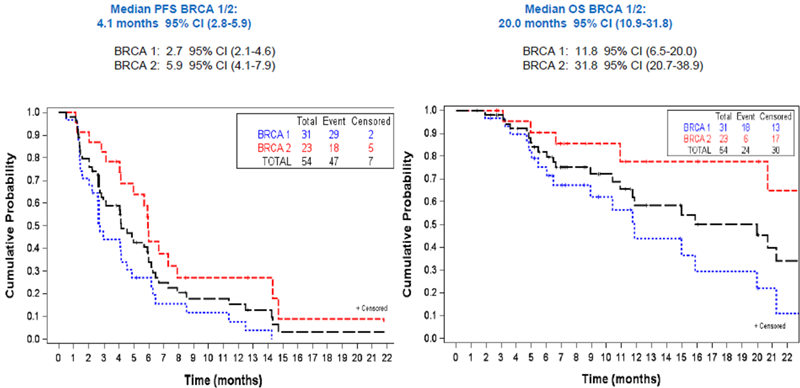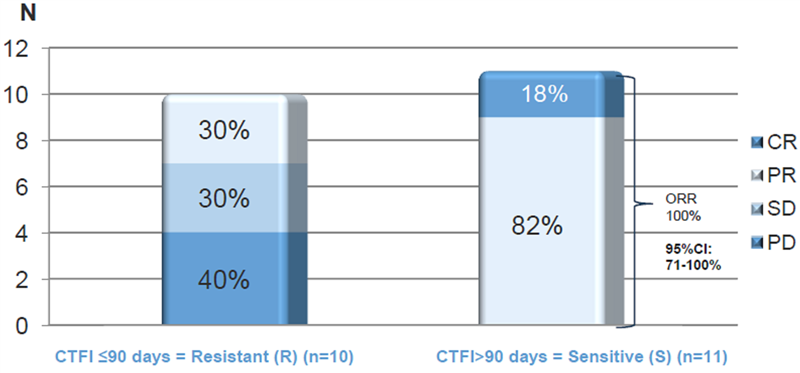Lurbinectedin: Pivotal studies in multiple indications
Lurbinectedin is structurally related to PharmaMar’s drug Yondelis, which is marketed for soft tissue sarcoma (STS) and platinum-sensitive ovarian cancer. However, lurbinectedin is being developed in different indications to Yondelis, including platinum-resistant ovarian cancer, SCLC and breast cancer. The compound has been optimised to improve the pharmacokinetic profile, such that lurbinectedin can be given at four times the tolerated dose level of Yondelis and offers administration advantages. lurbinectedin can be administered in a one-hour infusion using a peripheral intravenous catheter, compared to a 24-hour infusion with Yondelis via a central catheter.
Data are expected in H217 from a Phase III trial of lurbinectedin in resistant ovarian cancer (CORAIL), which completed recruitment in October 2016. The primary endpoint of the 443-patient trial is progression-free survival (PFS). A Phase III trial in SCLC (ATLANTIS) was initiated in August 2016, and we expect a pivotal trial in BRCA1/2 mutated breast cancer to commence in 2017.
Exhibit 3: PM1183 (lurbinectedin) development status
Programme |
Indication |
Stage |
Notes |
PM1183 (lurbinectedin) |
Platinum-resistant/ refractory ovarian cancer (PRROC) |
Phase III |
420-patient monotherapy CORAIL trial in platinum-resistant ovarian cancer commenced recruitment in June 2015. The trial is comparing PM1183 vs investigators’ choice of topotecan or pegylated liposomal doxorubicin (PLD). Recruitment completed in October 2016. In a Phase IIb trial PFS was 5.7 months for PM1183 vs 1.7 months for topotecan (p=0.0005). Orphan drug status. |
Small cell lung cancer (SCLC) |
Phase III |
600-patient ATLANTIS trial as second-line therapy in combination with doxorubicin in platinum-resistant SCLC. Recruitment commenced August 2016, with final results due in 2019. The trial will compare PM1183 plus doxorubicin against either topotecan or a combination of cyclophosphamide, doxorubicin and vincristine. In a Phase I trial in 21 SCLC patients, confirmed ORR was 67%, including 10% CR. |
BRCA1/2-associated breast cancer (BC) |
Pivotal trial pending |
117-patient two-part Phase IIb trial in BRCA1/2-associated or unselected metastatic BC ongoing. Results in 54 patients with BRCA1/2-associated BC were reported in October 2016: ORR 41% (22/54)); ORR was 61% in the BRCA2 subgroup and 26% in patients with mutations in BRCA1; PFS 4.1 months. |
Non-small cell lung cancer (NSCLC) |
Phase II |
69 pts recruited a three-arm Phase II of PM1183 ± gemcitabine vs docetaxel in second-line unresectable NSCLC. Primary endpoint: PFS at four months. Secondary endpoints: ORR, PFS/OS, histology. Phase I study + gemcitabine resulted in 1 CR, 4 PR and 7 SD in 19 evaluable NSCLC patients. We do not expect the company to pursue further development in NSCLC in the near term due to the number of drugs in development for this indication. |
“Basket” trial in advanced solid tumours |
Phase II |
225-patient Phase II of PM1183 in patients with advanced solid tumours, including SCLC, head and neck cancer, neuroendocrine tumours, biliary tract tumours, endometrial cancer, breast cancer, germ cell tumours and Ewing’s family of tumours. Primary endpoint: ORR. |
PM1183 drug combination trials |
Phase I |
Enrolment has been completed in Phase I trials of PM1183 in combination with doxorubicin, cisplatin, capecitabine and paclitaxel with or without bevacizumab. PM1183 in combination with both paclitaxel and paclitaxel plus bevacizumab produced promising preliminary results in a range of breast cancer types, and options for further development in this indication are being assessed. |
Source: Edison Investment Research, clinicaltrials.gov. Note: PFS = progression-free survival; IDMC = independent data monitoring committee; PTCL = peripheral T-cell lymphoma; ORR = overall response rate; CR = complete response; PR = partial response; SD = stable disease.
Positive Phase II in BRCA mutated breast cancer expected to lead to pivotal trial
In October 2016 PharmaMar announced positive results from its Phase II study of lurbinectedin in 54 patients with BRCA1/2-associated metastatic breast cancer who had undergone no more than three prior chemotherapy regimens.
A significant reduction in tumour size was reported in 22 of the 54 patients (ORR 41%); the primary endpoint of at least 17 responses was comfortably met. The ORR was 61% in the BRCA2 subgroup and 26% in patients with mutations in BRCA1. PFS was 4.1 months, median duration of response was 6.7 months and clinical benefit (tumour response or stable disease for at least three months) was observed in 61% of patients. Over the course of the trial, the initial dose of 7mg IV every three weeks was adjusted to 3.5mg/m2 every three weeks, which improved tolerability while maintaining efficacy.
The investigators concluded that lurbinectedin is active in BRCA-associated breast cancer independently of the prior treatment with platinum drugs. Exhibit 4 shows that response rates were highest in patients who had not undergone prior platinum therapy, who carried BRCA2 mutations, were hormone receptor positive or who had undergone fewer prior lines of chemotherapy. However, a meaningful proportion of patients in each of the less favourable subgroups also responded to treatment with lurbinectedin, including those with triple-negative breast cancer (TNBC).
Exhibit 5 shows that overall survival (OS) in the Phase II trial was substantially higher in patients carrying BRCA2 mutations than those with BRCA1 mutations (median OS 31.8 vs 11.8 months).
PharmaMar has stated that it intends to continue with the clinical development of lurbinectedin in BRCA-associated breast cancer, and in an investor conference call on 4 January 2017 indicated that this is most likely to be in BRCA2 subgroup, which experienced the highest response rates in the Phase II study. We anticipate that a pivotal study in this patient population could be initiated in 2017. We have increased our estimate of the likelihood of success in this indication from 15% to 45% in light of the positive Phase II results. We anticipate that we would further increase the likelihood when the pivotal trial is initiated.
Exhibit 4: Response rates in BRCA1/2-associated breast cancer sub-populations
|

|
Source: PharmaMar corporate presentation October 2016
|
Exhibit 5: Progression free survival and overall survival in BRCA1/2-associated breast cancer
|

|
Source: PharmaMar corporate presentation October 2016
|
There are varying estimates of the proportion of breast cancer patients who carry inherited mutations in the BRCA1 or BRCA2 genes. Some articles suggest that mutations in the BRCA1/2 genes account for 5-10% of cases of breast cancer overall., However, a number of those studies were in populations enriched for patients with a family history of breast cancer or who had breast cancer diagnosed at an early age, both of which would increase the likelihood of BRCA mutation.
A meta-analysis by Nelson et al (2013) reported a prevalence of 1.8% for BRCA1 and 1.3% for BRCA2 in breast cancer patients (ie 3.1% for BRCA1/2 combined). That analysis was conducted as part of a systematic review of BRCA testing prepared for the US Agency for Healthcare Research and Quality.
A study by Neuhausen et al (2009) reported BRCA1/2 mutation frequencies from several large breast cancer family registries. In over 3,600 families from three population-based family registries the frequency of mutations was 4.0% for BRCA1 and 3.7% for BRCA2 (total 7.7%). However, in two of these registries there was over-sampling based on younger age at diagnosis and cancer family history, both of which would be expected to increase the frequency of BRCA mutations. In ~1,600 families where there was no family history of breast cancer the frequency of mutations was 2.4% for BRCA1 and 2.2% for BRCA2 (total 4.6%) – we believe that this figure is a better indicator of the frequency of BRCA1/2 mutations in the overall population.
In our forecasts we assume that 2% of breast cancer patients carry BRCA2 mutations, a figure that is between the estimates of Nelson et al and the Neuhausen families where there was no family history of breast cancer. With 650,000 new cases of breast cancer each year in the US, EU and Japan, we estimate that there would be 13,000 cases of BRCA2-associated breast cancer each year in these markets. Although this is a relative small patient population, we would expect a high market penetration for a drug that is specifically targeted to the treatment of this patient group.
Phase III underway in small cell lung cancer
PharmaMar initiated a second pivotal study of lurbinectedin in August, which is recruiting patients with small cell lung cancer (SCLC). The ATLANTIS Phase III study builds on the impressive efficacy seen in a SCLC expansion cohort in a Phase Ib study. Preliminary results from the Phase Ib study showed that 67% of SCLC patients responded to lurbinectedin plus doxorubicin (including 10% complete responses), compared to response rates of 20-25% typically seen with standard-of-care drug topotecan. In patients who initially responded to first-line chemotherapy before relapse, the response rate was 100% (Exhibits 6 and 7).
ATLANTIS is a multicentre, open-label, randomised Phase III trial in 600 patients with relapsed (second-line) SCLC following platinum-containing therapy. The primary endpoint is progression free survival (PFS) comparing patients treated with the combination of lurbinectedin and doxorubicin to the control arm where patients are treated with either topotecan or the CAV regimen, a combination of cyclophosphamide, adriamycin (the brand name for doxorubicin) and vincristine.
Exhibit 6: SCLC – maximum tumour size variation according to response to first-line chemotherapy
|
Exhibit 7: SCLC – best confirmed response according to response to first-line chemotherapy
|

|

|
Source: PharmaMar corporate presentation. Note: Sensitive = chemotherapy-free interval (CTFI) > 90 days after first line therapy; Resistant = CTFI ≤ 90 days; PD = progressive disease; PR = partial response.
|
Source: PharmaMar. Note: CR = complete response; CTFI = chemotherapy-free interval; PD = progressive disease; PR = partial response; SD = stable disease.
|
Exhibit 6: SCLC – maximum tumour size variation according to response to first-line chemotherapy
|

|
Source: PharmaMar corporate presentation. Note: Sensitive = chemotherapy-free interval (CTFI) > 90 days after first line therapy; Resistant = CTFI ≤ 90 days; PD = progressive disease; PR = partial response.
|
Exhibit 7: SCLC – best confirmed response according to response to first-line chemotherapy
|

|
Source: PharmaMar. Note: CR = complete response; CTFI = chemotherapy-free interval; PD = progressive disease; PR = partial response; SD = stable disease.
|
SCLC patients constitute 10-15% of total lung cancer patients, representing ~80,000 cases in the US, EU and Japan in 2016 (assuming SCLC comprises 12.5% of all lung cancers). They respond well to first-line treatment, but almost always relapse, with treatment options then largely palliative. About 10% of the total population of SCLC patients remains disease free two years after the start of therapy. The overall survival at five years is 5-10%, reflecting a clear medical need for improved treatment.









